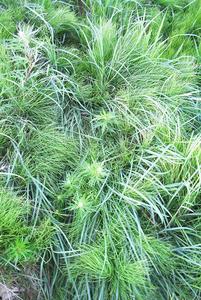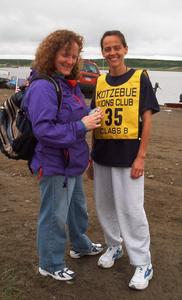
|
4 July, 2003Three Cheers for the RED, WHITE and BLUE! Today in Kotzebue What Science Is Happening?
The dancing was very fascinating. The drummers played and sang traditional songs while people, from the very young to the elders, acted out the dances. This is one way to pass down traditional hunting knowledge. Each move holds meaning, some of the observable moves, pantomimed hunting and traveling. Other Inupiaq games helped keep people fit for survival and teach skills to the young. The one-foot kick had contestants jump up and kick a fur ball on a string with one foot, then landing on the same foot only. This improved strength, balance and flexibility. The ball started at 36 inched high but was moved up a few inches every round. The winner was out at 100 inches, yes, 8 feet 4 inches. He couldn’t even reach the ball with his hands to steady it before his attempts. Other events were a two-foot ball kick and a blanket toss. A large round sealskin blanket is stretched tightly between a group of men. They pull tight and the person in the middle of the blanket is pitched high in the air.
We expect that different animals/organisms will live in different depths of water. An area 2 feet deep gets more sunlight than an area 50 feet deep. This changes the amount and type of plants that can live there and the types of animals that feed on them. 2.) I could not see very far down in the water, even when we were in 2 feet. Does then mean that the water is dirty or clean? Is there more likely to be life in murky green water or clear blue water, why or why not? There is a combination of things. We are at the base mouth of several rivers. This is an ESTUARY (see below) system. That means that the water draining into the sound from surrounding rivers and marches stirs up the mud from the bottom. The green, however, comes from phytoplankton, small plants suspended in the water. So very clear water, with no plant matter could possibly be very barren or free of life. If no plants are available for the lower trophic levels (little fish), then there are no bigger fish to eat them. Another possibility in very clear water, such a coral reef, is that the plants are being consumed so fast the water is clearer. So, is the water dirtier? Yes AND it has more plants but it also has more life. 3.) The 4th of July is a big celebration, but they don’t have fireworks, why? (Hint: They DO have them on New Years Eve.) As it is light 24 hours a day, you couldn’t see them! 4.) What other things have you heard a GPS being used for? How about to find where something else is? Most semi-trucks have units on them that can be tracked by satellite. Cars anti-theft devices access GPS. As soon as a car is reported stolen, the police can type up the tracking number and satellites tell them exactly where the car is. Also, cars with GPS are now being made with on-board computers. So drivers will never get lost. They will always have a map of the roads around them. Prince William of England wears one around his wrist. If he were lost or kidnapped, the police could find him quickly. What about doing that for all kids? Wouldn’t that help find lost children? What ideas did you come up with? Words to Know Estuary:Part land, part sea...where fresh river water and salty sea water mix. Links Learn
more about our project here
Contact the TEA in the field at . If you cannot connect through your browser, copy the TEA's e-mail address in the "To:" line of your favorite e-mail package. |









